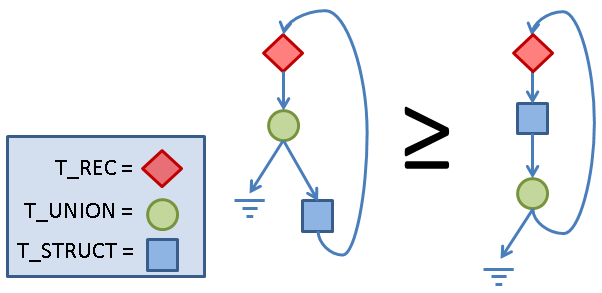A Problem with Structural Subtyping and Recusive Types
One problem causing me a headache is how to implement structural subtyping for recursive types (which I first blogged about here). The following example illustrates the basic idea:
define Link as { int data, LinkedList next }
define LinkedList as null | Link
LinkedList f(Link list):
return list
This is a fairly straightforward definition of a linked list, along with a dumb function f() that just returns its parameter. The key here, is that for f() to type check, we must show Link to be a subtype of LinkedList. In otherwords, to show that Y < {int data, null|Y next} > is a subtype of X < null | {int data, X next} >.
Here’s a pictorial representation of the problem:

Now, the following illustrates my current (abbreviated) subtyping implementation, with each rule annotated with its corresponding name from the technical report:
define T_INT as 1
define T_NULL as 0
define T_UNION as {Type} // a union (i.e. set) of types
define T_STRUCT as {string->Type} // map fields to types
define T_REC as { string var, Type body } // recursive types
define Type as T_INT | T_NULL | T_REC | T_UNION | T_STRUCT
bool isSubtype(Type t1, Type t2):
if t1 == t2:
return true
else if t1 ~= T_UNION:
// rule S_UNION1
for Type t in t1:
if isSubtype(t,t2):
return true
return false
else if t2 ~= T_UNION:
// rule S_UNION2
for Type t in t2:
if isSubtype(t1,t):
return true
return false
else if t1 ~= T_STRUCT && t2 ~= T_STRUCT
&& dom(t1) == dom(t2):
// rule S_DEPTH
for (f->t) in t1:
if !isSubtype(t,t2[f]):
return false
return true
else if t1 ~= T_REC && t2 ~= T_REC:
// rule S_RECURSE
return isSubtype(t1.body,t2.body)
else if t1 ~= T_REC:
// rule Q_UNFOLD (part of)
t1 = unroll(t1)
return isSubtype(t1,t2)
else if t2 ~= T_REC:
// rule Q_UNFOLD (part of)
t2 = unroll(t2)
return isSubtype(t1,t2)
else:
return false
The unroll() function does what you’d expect: it takes a recursive type and substitutes its body for itself. So, for example:
X < null | {int data, X next} >
unrolls to this:
null | {int data, (X < null | {int data, X next} >) next}
Unfortunately, isSubtype() will not conclude that Link is a subtype of LinkedList. The problem is that, on entry, we have two instances of T_REC with different bodies. Thus, isSubtype() will attempt to recursively identify whether the first body is a subtype of the second (which it is not because it ends up with the case isSubtype(X,null|X)).
Apparently, the following papers tell me how to solve this problem:
Efficient Recursive Subtyping, Dexter Kozen, Jens Palsberg and Michael Schwartzbach. POPL, 1993. [ACM DL] [PDF]
Subtyping Recursive Types, Roberto M. Amadio1 Luca Cardelli, TOPLAS, 1993. [ACM DL] [PDF]
Efficient Inclusion Checking for Deterministic Tree Automata and DTDs, Jérôme Champavère, Rémi Gilleron, Aurélien Lemay, and Joachim Niehren, 2008. [PDF]
… I just need to figure them out first!
